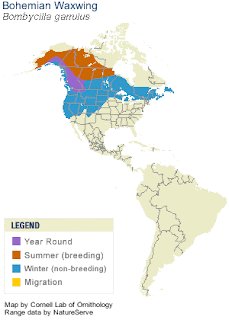To start off, the distribution of the two species are quite different. For instance, by looking at the following Range Maps, you can see that during summer months, it would be uncommon to find Bohemian Waxwings in Ontario. However, there is clear overlap in wintering months, and Bohemian and Cedar Waxwings will often be found in the same area. During the winter it is not uncommon to see both species in the same flock! However, if you were to see a waxwing in the summer, its very likely its a Cedar Waxwing.
Cedar Waxwing:
1) Cedar Waxwings are Smaller (But they're similar in size)
2) They have Yellow Bellies
3) They're call is higher pitched than Bohemians
3) They're call is higher pitched than Bohemians
Bohemian Waxwing
1) Rufous (reddish) under tail and face
2) Large than Cedar Waxwings (But similar in size)
3) Have white wing edges (Hard to see in some of the following pics), but noticeably different than Cedar Waxwings













































